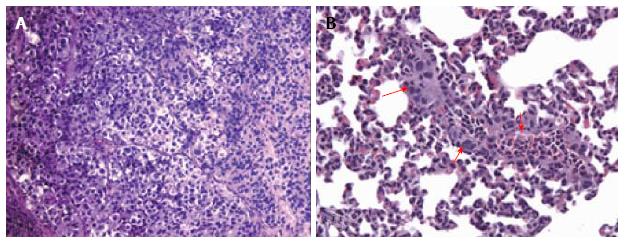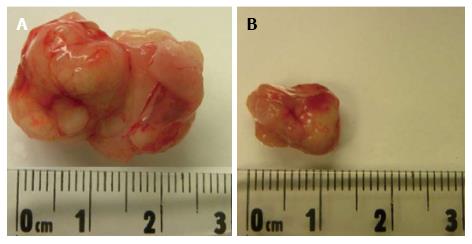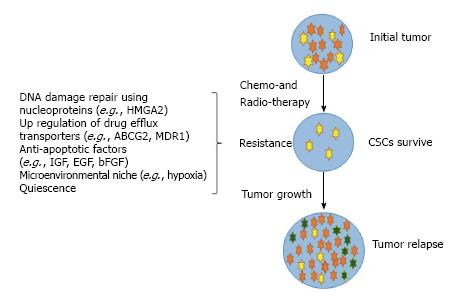Copyright
©2014 Baishideng Publishing Group Inc.
World J Stem Cells. Nov 26, 2014; 6(5): 614-619
Published online Nov 26, 2014. doi: 10.4252/wjsc.v6.i5.614
Published online Nov 26, 2014. doi: 10.4252/wjsc.v6.i5.614
Figure 1 Histological images showing subcutaneous thyroid cancer mouse model.
A: Hematoxylin and eosin stained microphotograph of tumor xenografts engrafted human thyroid cancer cell line (K1) with adipose-derived stem cells (ASCs) (× 100); B: HE microphotograph of lung metastasis (red arrows) in the group transplanted with K1 cells and ASCs (× 200). Methods of image acquisition: Tumor and organs removed from mouse, photographed, and stored in 10% neutral buffered formalin for paraffin sectioning and HE staining. Tumor tissue were sectioned and stained with HE[28].
Figure 2 Representative tumor from severe combined immunodeficiency mice injected with: (A) K1 + ASCs and (B) K1 alone.
ASCs: Adipose-derived stem cells.
Figure 3 Adipose-derived stem cells promote tumor growth of papillary thyroid cancer cells.
K1 cells alone and K1 cells with ASCs (5 x 105 cells each) were injected subcutaneously into nude mice (n = 5, each group)[28]. ASC: Adipose-derived stem cell.
Figure 4 A schematic representation showing cancer stem cells resistance to chemo-and radio-therapy causing tumor to relapse.
Cancer stem cells (CSCs) (yellow) with differentiated cells committed to a particular lineage (red). Ability of CSCs to resist anti-cancer therapy due to various mechanisms and ability to proliferate into heterogeneous group of cells cause tumor to relapse. HMGA2: High mobility group A2; ABCG2: ATP-binding cassette sub-family G member 2; MDR1: Multi-drug resistance protein-1; IGF: Insulin-derived growth factor; EGF: Epidermal growth factor; bFGF: Basic fibroblast growth factor.
- Citation: Bhatia P, Tsumagari K, Abd Elmageed ZY, Friedlander P, Buell JF, Kandil E. Stem cell biology in thyroid cancer: Insights for novel therapies. World J Stem Cells 2014; 6(5): 614-619
- URL: https://www.wjgnet.com/1948-0210/full/v6/i5/614.htm
- DOI: https://dx.doi.org/10.4252/wjsc.v6.i5.614












